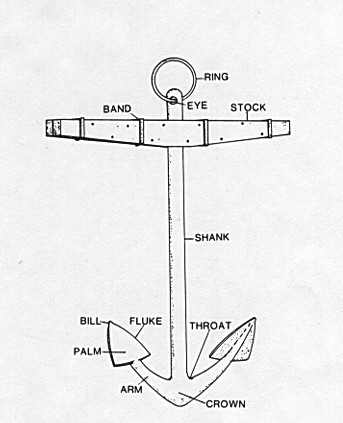Archaeological Investigations
Indiana University has recognized the Spanish Anchor site for its archaeological and biological significance as well as for its educational and recreational potential. In 1986 an ongoing assessment of the Spanish Anchor was undertaken by IU to provide resource managers with baseline biological and archaeological data to aid in their evaluation of the site. Subsequent IU surveys of the site have generated the hypothesis that specific analysis of the Spanish Anchor- as a microcosm of the reef- has broader implications for the general well being of the Molasses Reef ecosystem. Furthermore, quantitative data, in conjunction with a historical perspective and archaeological context, can be incorporated into useful educational templates. By developing simple methodologies for the public to utilize, these educational templates encourage continued documentation of the site, and fosters a preservational attitude among user groups, thus affording the Spanish Anchor additional site protection.
The Spanish Anchor is thought by Indiana University archaeologists to be representative of a late 18th-early 19th Century Western European-style anchor. The general form of anchors from this time period is typified by a classic, iron arrow-shape with a long shank, angular arms, and a wooden stock. The previously exposed wooden stock of the Spanish Anchor has disappeared almost completely, but evidence of a stock key signifies previous presence of a wooden stock (Baelz, 2021). The large anchor ring is another diagnostic indicator of manufacture date- the large ring was necessary before the late 18th Century to attach the massive hemp rope as an anchor line, since anchor chain was not utilized in this earlier time period (Indiana University 1996).
While a fairly specific time period can be assumed through known anchor morphology (opposed to anchor morphology that is accepted but has not been archaeologically confirmed), national origin cannot be determined definitively at this time with no known context (Indiana University 1996). Anchor styles have historically transcended national identity, making it almost impossible to determine the exact nation of origin. During the time period in which this anchor is believed to be representative, however, Spain was a dominant seafaring force, and other similar anchor styles are known to have come from Spanish ships of this time period and general location. Because of this, combined temporal and geographical data and diagnostic anchor morphology have led to speculation of Spanish origin. Particular attention should be given to feature characteristics such as: arm angle, ratio of length of shank to width of fluke; size, shape, and design of palms; and the style of ring attachment in order to provide more conclusive data on the time period and origin from which this anchor was manufactured and used (Indiana University 1996). Trace elemental analysis would increase the understanding of manufacture, provenience, and possibly chronology of iron anchors, separate from morphology or suspected origin (Maus et al. 2014). Through comparative analysis of trace elemental compositions with artifacts of relatively secure date and provenience, this methodology could potentially be used to constrain ages and provenance of iron artifacts even if artifact morphology is obscured by encrustation or misinterpretation (Maus et al. 2014).
Suspected Spanish origin can be supported by the enormous European exploration exploitation that fueled an era of Spanish mercantilism, relying heavily on trade routes that depended on the Florida straits for the return voyage (Indiana University 1996). Goods were gathered and loaded onto merchant vessels in Havana, Cuba, destined for Spain and farther. Many ships met their doom in the shallow reefs off the coast of the Florida Keys; the discovery of potential riches in the New World drew other sea-faring countries such as Spain, England, France, Denmark, and the Netherlands to and led to fierce rivalries (Indiana University 1996). The competition for dominance in this triangle of trade was represented between nations by the power and prestige associated with the wealth of land and riches acquired from the New World. The Spanish Anchor is representative of these historical events, with a wrecked merchant assumed to be of Spanish origin (Indiana University 1996). Indiana University 1989 magnetometer survey and subsequent visual surveys did not associate the Spanish Anchor with a known shipwreck.
Major Features: Iron anchor 10’5” inches in length from ring to crown, 7’3” inches in width from palm to palm, with extant, unattached anchor ring.
Signs of Deterioration: Deterioration of the anchor shank seen by the detached ring, likely a product of unsupported anchor weight resting upon the anchor ring (Baelz 2021). The missing wooden stock, due to the saltwater environment, has been noted in previous reports, as well as the slight bend in the anchor shank.
Damage or Removal of Cultural Heritage: The ring has been detached from the rest of the anchor and lies disconnected, above the feature. Deterioration was likely a product of time and/or natural weather events rather than anthropogenic impact.
Exposed Artifacts: N/A
Features Vulnerable to Diver Impact: Detached anchor ring.
Protection: Its federally protected status, accessibility, limited archaeological sensitivity, and recreational and educational potential make the Spanish Anchor a continued site of archaeological and recreational interest, worthy of additional protection (Indiana University 1996).
(Baelz, 2021).
Arm-Part of the anchor extending from the crown end of the shank and connecting to the palm.
Band-Metal loop securing the two sections of the wooden stock together and to the shank.
Bill-Very tip end of palm.
Crown-The pointed end of the anchor which attaches the shank to the arms.
Eye-Hole in the end of the shank through which the ring is attached.
Fluke-The spade shaped appendage of the arm used for digging into the sea bed in order to secure the vessel.
Palm-Flat upper most portion of the fluke.
Ring-The working end of the anchor which rope or chain was attached to connect the anchor to the vessel.
Shank-The vertical stem of the anchor.
Stock-Cross bar of the anchor which turns the anchor into an attitude that enables the fluke to dig in to the sea bed.
Throat-The curvature between the shank and the upward part of the arm.


